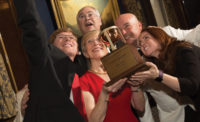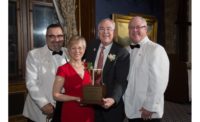It’s an impressive resume: Chocolatier; entrepreneur; political activist; consultant; new product developer; foundation chairman; industry volunteer; philanthropist. Of course, let’s not forget wife, mother and foodie.
Sara Clair’s accomplishments cover a lot of territory. But if there are two reoccurring themes that connect Candy Industry’s 72nd Kettle Awards recipient to all the hats she’s worn and wears, it’s chocolate and the kitchen table.
As one might expect, Clair’s love of chocolate started at an early age, and at the kitchen table.
“I was 8 when I made my first batch of chocolate chip cookies,” she says. “Brownies followed shortly thereafter.”
As Clair goes on to explain, her mother was an excellent cook. And one of her grandmothers was a baker and candy maker, albeit not a professional.
“She simply made it for the family,” she adds.
At-a-Glance: Brown & Haley
Headquarters: Fife, Wash. (165,000 sq. ft.)
Plant: Tacoma, Wash. (110,000 sq. ft., three major lines)
Sales: $60 million - $70 million (Candy Industry estimate)
Employees: 300
Output: 2.5 million Roca brand pieces daily
Roca brand confections are sold in 65 countries
Brands: Almond Roca, Cashew Roca, Mocha Roca, Peppermint Roca, Dark Roca, Macadamia Roca, Sea Salt Caramel Roca, Roca Thins, Mountain Bars, Mountain Thins
Products: Buttercrunch toffee, chocolate bark, caramel, clusters, chocolate mints, bars.
Management team: Pierson Clair, vice chairman & ceo; John Melin, president and coo; David Armstrong, sr. v.p. supply chain /operations; Sara Clair, director of product development; Ken Rosenberg, director of U.S. sales; Rick Nicks, director of international sales; Kathi Rennaker, director of marketing.
Oh yes, cook books happened to be her romance novel of choice as a tween.
“I loved reading the Good Housekeeping cook books, eventually moving up to Julia Child and Lenotres.”
But Clair did more than simply enjoy reading cook books, she embraced the craft.
“Food is my art,” she exclaims. “It was fun for me to experiment.”
The experiment evolved into experience as she began working in catering while in high school, eventually specializing in making desserts and confections.
“You have to remember that at the time [mid 1970s], the Bay Area, beginning with Chez Panisse, was the leading edge for food entrepreneurs,” Clair points out.
It was within that environment Clair enrolled at Stanford University, taking her culinary creativity with her. It’s no surprise then that Clair’s major was going to be “interdisciplinary,” a self-driven program that involved taking formal classes alongside research courses.
“You could take business school classes alongside industrial engineering; it was a marvelous time,” she recalls with a smile.
It was during this period (1978) that Clair not only took on a full academic load, but also kicked off her new business, chocolate truffles. The enterprising young woman had developed a methodology to extend the shelf-life of her premium, fresh cream Silver Elegance truffles.
She hand-dipped at night, attended classes in the morning and delivered to the Bay area’s gourmet retailers in the afternoon. Driven is one way to describe her.
Upon completing her masters, Clair committed to starting her own business.
“I signed a lease to sublet factory space in Redwood City,” she says. “The company was called the Ultimate Food Co., since chocolate is the ultimate food. I also joined RCI [Retail Confectioners International]."
In 1983, Clair looked to show her products to the world by exhibiting at the Winter Fancy Food Show in San Francisco’s Moscone Center.
“At that time, there was only one Moscone Center, not like the two they have today that are connected by an underground walkway,” she says. “All the new exhibitors were relegated to a room under the escalator, while established companies were located in the main room. However, 15 minutes before the show opened, I received word that a space had opened up in the main room because one company failed to arrive. The show organizers asked me, since I was first on the list [she had signed up a year in advance] if I wanted to move to the large hall. So I packed up my products and went from a 10 x 10 to a 10 x 20 booth. It was like getting an upgrade; it was marvelous. There were buyers from across the country.”
Of course, it would be like Clair to register for the show a year in advance. It’s part of that interdisciplinary mix that has served her so well. It’s also a personality trait that caught the eye of Pierson Clair.
At the time, Pierson was working for Blommer Chocolate Co. as its West Coast Vice President. After calling on her as a potential customer — he was initially rebuffed several times — Pierson realized he was attracted to the accomplished chocolatier, regardless whether she was going to buy his chocolate or not.

“I remember our first date; I took her to Ghirardelli Square,” he says. “I asked if she wanted a hot fudge sundae. She declined, explaining that she sampled chocolate all day long. Well, I ordered one. It was then I noticed she began sampling my sundae. I knew then she was my kind of woman.”
Marriage followed suit, then children, Elizabeth and Pierson IV. During this time, Sara continued to work as a consultant, focused on product development. As the children grew, so did their role in being their mother’s taste panel.
“Everything starts in the kitchen,” she explains. Thus, it wasn’t unusual to see product samples laid out along with score sheets during the week. Math drills were conducted using Oreo cookies and Jelly Belly jelly beans.
Even trips to the supermarket reflected Sara’s work in the kitchen as she pointed out successful new product launches on the shelves, which had their origins at home.
“How many people do you know that have a Hilliard’s chocolate melter and a Robot Coupe food processor in their kitchen?” she asks.
Sara’s creativity in the kitchen took on a more personal connection when Pierson accepted an offer from Brown & Haley in 1997 to become president of the company.
“It was the perfect next step,” she explains. “Here was the opportunity to take a beloved iconic brand and strengthen it by adding flavors and focus.”
Thus, when Sara joined Brown & Haley’s research and development team in 1998, she was both thrilled and cautious.
“Almond Roca was what we called an ‘orphan brand,’” she says. “There was just one flavor and perhaps two package sizes. Almond Roca was the brand. We wanted Roca to be the brand while introducing new flavors, such as cashews or macadamias.”
Nonetheless, the first rule of thumb was to see what consumers were saying about the brand, finding out what they would like to see. Fortunately, for Sara and Pierson, a local drug store chain, Bartell’s, happened to be the perfect proving ground for customer feedback.
The chain, which was 22 years older than Brown & Haley — it was founded in 1890 while Brown & Haley emerged in 1912 — had a tremendously loyal clientele who were Almond Roca fans.
Nonetheless, when it comes to introducing a new flavor or product, “The consumer has to give you permission,” Sara emphasizes. After experimenting and testing with a multitude of flavor options, Sara and her team launched Mocha Roca, which featured dark chocolate and espresso beans.
Again, thanks to extensive sampling — Brown & Haley has an outlet kiosk outside its manufacturing plant that draws loyal customers continuously, an ideal format for testing new product launches — Mocha Roca debuted.
It was a success, but then the groundwork had been laid for its acceptance.
As Pierson explains, it took 80 years (Mocha Roca debuted in 2003) before Almond Roca had a companion flavor.
Since then, the company has launched 14 new products and five additional Roca flavors — Cashew, Dark, Macadamia, Peppermint and most recently, Sea Salt Caramel.
All have been successful. Sea Salt Caramel, which will come out this fall, promises to be a rookie sensation, with expectations that it will soar to No. 2 in sales within a couple of years.
“We’re a small company, and when we launch a new product, it has to be right,” he says.
Of all the new Roca flavor launches, Dark Chocolate proved to be the most challenging.

“It was critical to find the right chocolate, one that would blend nicely with the warm butter flavors,” Sara explains. “We wanted a dark chocolate component but without the strong tannins or one that was too mild. It took us six months and 50 samples before we decided on the right chocolate.
“It’s all about the scientific method,” she says. “You change one thing at a time and then sample it. There are no surprises.”
That process provides the R&D team the confidence it needs to choose the right recipe before launch. It also allows a free-wheeling approach to ideas and innovations.
As Pierson explains, the research and development team, which incorporates Pierson, Sara and John Melin, the company’s president, and Kathi Rennaker, director of marketing, as well as heads of manufacturing and others as needed, is in constant percolation.
“I’ll be walking through the plant when someone will draw me aside and tell me we should consider doing a coconut Roca,” Pierson says. “And I’ll tell them to explain this to me, the reasons why, etcetera. And I’ll take it back to the team and we’ll discuss it.”
As it turns out, there are some production challenges with coconut, but that doesn’t mean the idea is dead. It’s simply on hold for further review. In the interim, there are plenty of projects in the pipeline, such as packaging.
“We’re always updating packaging, developing different package sizes, sometimes for specialized gift baskets and other times customized for a retailer,” Sara says.
But as one would expect from an individual who has bachelor’s and master’s degrees, Sara’s world extends beyond just product development. It also encompasses grass-roots politics, industry involvement and foundation work.
One would be remiss in not pointing out Sara and Pierson’s efforts in advocating Initiative 1107, which repealed the state tax on candy in Washington.
“There were a lot of phone calls and meetings,” she recalls. Six months of those, to be exact.
“It was an opportunity to educate and then hope common sense would prevail,” Sara explains. It worked; the initiative to repeal the candy tax passed with a 60 percent approval rate.
Typically, one kind of success gives birth to another. In this instance, Sara’s involvement in Initiative 1107 as well as her work with the Greater Metro Parks Foundation in Tacoma, led to what many view as one of her crowning achievements. In 2011, then NCA President Larry Graham asked Sara to become chairman of the newly formed Confectionery Foundation.
“The paperwork for the foundation had just been finalized as a non-profit 501(c)(3) non-profit organization,” she recalls. “Bill Kelley of Jelly Belly was asked to serve as vice-chairman. The role of the foundation was still unclear, but we had three main goals: education; philanthropy and research.”
Surprisingly, all it took was one day to determine exactly what the foundation’s focus should be. After an eight-hour strategic meeting, it was clear that the industry had jobs that needed to be filled, but that there weren’t enough skilled workers to fill those jobs.
“So here it was November, and we have the largest gathering of confectionery companies in the United States coming up in May,” she explains. “The challenge was how to get young people to come in and learn about the industry.”
The cold-calling of schools began in earnest. The kitchen table became command central, Pierson recalls. “Sara loves spreadsheets,” he adds. She does and they work for her.
At the Sweets & Snacks Expo in 2012 — for the first time — there were 50 students and faculty representing four schools. Despite having no funding, it was an auspicious start for the Foundation.
Now in its sixth year, The Confectionery Foundation selected 100 students and faculty from 23 schools across 10 states to learn about the industry during the Sweets & Snacks Expo in May. Twenty of those students were in robotic engineering programs, 20 in food science, 15 of which were advanced degree programs, 30 from culinary schools and the remaining from business, marketing, graphics, advertising, and communications programs.
“These are the kinds of students we need to fill jobs in the industry,” she says. This year, the Confectionery Foundation’s Next Generation program for students visiting Sweets & Snacks Expo — which they do at their own cost — included a Career Fair. Seven companies — ADM, Barry Callebaut, Elmer Candy Co, Ferrara Candy Co., Edward Marc Brands, Lindt North America, and Mondelez International participated.
100 volunteers from the industry act as mentor guides, booth hosts, speakers, and company representatives at the career fair during the Sweets & Snacks Expo, Sara explains. The students are segregated into groups of seven or fewer matched with an appropriate guide. For example, Katherine Clark from Capol led a group of food science students while Rob Nelson from Elmer’s Candy, guided business students and Mary Beth Geraci, Carlin Group, hosted marketing.
The student groups typically have two booth appointments scheduled in the morning, which allows them time to be guided through the Expo. “Then there’s lunch in the briefing room,” she continues. “So, for example, we had a panel of young professionals discussing the transition in business communication skills from college to the professional world. Engineering students engaged in discussion with Herm Rowland, Karen Brown and Jim Greenberg while others were given a virtual reality tour by Mark Lozano of tna North America.”
The Career Fair follows lunch and then there’s a return to the show floor. A Thank You reception concludes the day’s activities, whereby college students mingle and share their resumes with the mentor guides and other industry professionals.
Organizing such an effort with so many moving parts can be overwhelming. Thank goodness for Sara’s love of spreadsheets. The “spreadsheet lady” proudly displays a color-coded poster board that detailed all student and mentor guide activities during that Wednesday at the Sweets & Snacks Expo. Event planners, take note.
Obviously, the Confectionery Foundation has come a long way. Sara credits the volunteers, many of them executives and leaders in the industry, who willingly give their time. And there’s more to come: the organization is in the process of working with companies to establish internships and an engineering scholarship fund and expanding the map of American candy factory tours and outlets at ConfectionLink.org/plan-trip. Naturally, this year’s Kettle Awards recipient invites anyone who’s interested in volunteering to send her an email at Foundation@ConfectionLink.org
As intense as is her involvement in the Confectionery Foundation, she’s also vested in the NCA’s CandyPAC and Washington Forum, urging all candy makers and suppliers to participate.
“It’s really an important event where members of our industry can make their voices heard in our nation’s capital,” Sara says. She cites the creation and growth of the Candy Caucus (members of Congress who support legislative issues involving the industry) as well as the last vote on reforming the Sugar Program in the Farm Bill (most support ever from Congressional leaders on revamping the Sugar Program).
“It’s the best way to educate officials about what is important to our base, to understand how families in our communities are affected,” Sara says. “They do pay attention to what we’re saying. It’s our chance to be engaged citizens.”
And she also encourages candy makers to attend the Western Candy Conference, an organization that’s close to her heart as well as her organizational prowess.
“It’s just called Western because the conference is held out West, but it’s open to everyone,” Sara points out. Not only is it educational and a networking gold mine, she adds, but it’s done in a manner that’s more relaxed and “in the spirit of the West.”
Next year the Western Candy Conference will mark its 85th anniversary. And, thanks to Sara’s formidable organizational skills, the group has made several improvements, ranging from earlier announcements about the annual meeting and website registrations to an improved site selection process and the introduction of sponsorship opportunities.
Despite all these accomplishments, Sara remains focused on doing the work. Regardless whether it’s helping grow Brown & Haley through new product launches and new packaging; building the Confectionery Foundation’s success stories; expanding participation in the Washington Forum and Western Candy Conference; or hosting guests for a Taste of the Northwest, she’s on it.
Her kitchen never closes.
See also: Sara's Soiree: Sara Clair captures 72nd Kettle Award























